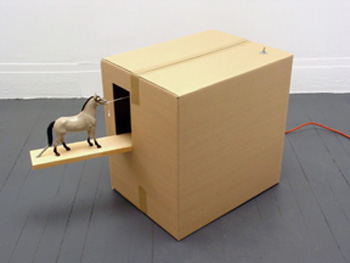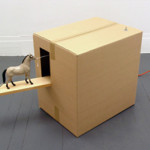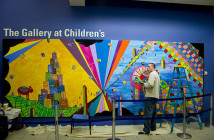When an artist represents something, whether they be a writer, painter, sculptor, etc., they must determine, among other things, how much they would like to show and tell us in order achieve that representation. The artist Robin Mandel tries to get away with telling us as little as possible, to give us what he deems “just enough information to convey the thing’s identity.” In his work, the “thing” can be an object, scenario, or common phrase, but he ultimately desires to leave us with our own, individual idea of what he represents with each work — our experiences and memories filling in the literal and implied spaces he leaves around and within each work.
The most popular of his works at the Green Street Gallery’s Robin Mandel: Sculpture show seem to be his essentialist extractions from common scenarios. The works are motorized concoctions made of various found objects and wood, one of which, “Nights and Weekends” (2004) entails an iron and ironing board connected by a cardboard box to two wine glasses set on a wooden platform. When turned on, motors inside the box, via exposed metal control arms, operate a spray bottle that squirts water onto the heated iron, generating steam, and the wine glasses clink together. The resulting motions and sound make a narrative of a night or a weekend more evident to the viewer. In a way they narrow the spectrum of possible interpretations by adding physicality to each piece and its individual elements and so illustrating the elements’ relationships. The works “Moving Day” (2004) and “Dinner” (2005) each employ similar methods to allow us to imagine certain scenarios, but his last motorized kinetic piece in the show, “Royal Pain” (2005), is more of a rebus for the concept of a royal pain: an ax grinds slowly over a crown while a child’s shoe taps slowly off to the side.
Every one of Mandel’s works in the show uses a different number of signifiers and varying degrees of signification to reach his finished work. A tool he uses his kinetic works is narrativity, a quality he reaches through the juxtaposition of multiple signifiers in order to represent the occurrence of events. Mandel’s works fluctuate in their use of narrativity to represent meaning, but narrativity is one of the tools he uses to maintain a “sense of connectedness” with his audience. Mandel discusses “sense of connectedness,” which he sited from an essay by Jonathan Franzen, as a principle of his own work. In the essay, Franzen discussed what are, in his mind, the two types of fiction. One, which invites “a discourse of genius and art-historical importance” and the other, which balances “self-expression and communication.” In this type, “the deepest purpose of reading and writing fiction is to sustain a sense of connectedness.” It is after this “model” of fiction that Mandel wishes to work.
Mandel’s works are self-consciously lo-fi. His cardboard boxes and exposed mechanics imply limited resources. Mandel attempts to generate the most narrativity out of the least amount of materials. He writes that he wishes to evoke “a convincing version of reality within a given set of constraints” in the same way as Bunraku puppetry, improv or mime work. His boxes and moving mechanical parts are analogs for the performers and performers' tools of the aforementioned art forms. He writes: “The magic that occurs is that we become simultaneously aware of both the problem and the solution. We can see the puppeteer in black, we can see that there is no teacup in the mime’s hand, but we can also see that the drama portrayed still resonates, despite these rifts in the illusion.” One of the goals of the performer, in these forms of performance, is to not reveal the artifice, however. The audience is amazed by the illusion created by limited resources, but if they consider the artifice whilst the performance, the artifice has failed. By exposing his artifice, Mandel frames his work within “a discourse of genius and art-historical importance” and doesn’t balance the “self-expression and communication” which he aspires for.
In his other work in Sculpture, Mandel makes an attempt to find meaning with less. He continues to play with signification, making “literal” representations as in the case of “Big Bat” (2003), an oversized, wooden baseball bat painted matte black, perhaps to remove from it any significance aside from its readily apparent shape and form. In “Window” 2004, Mandel made a three dimensional figure of a 3D drawing. He has given the viewer his interpretation of the essence of a window, in his attempt to create an “ideal instance” of a window. Interestingly, though it seems unintentional, the materials used all represent for “Big Bat” and “Window” are both representative of the objects that they are modeling. “Bat” is indeed made of solid wood, and “Window,” of welded steel—just like the bars on an apartment’s windows in the neighborhood where the Green Street Gallery resides. The Jasper Johns-esque, case bronze “Wiffle Ball King” (2005) further considers the signifier/signified relationship; Mandel created an object d’art by modeling a wiffle ball of the brand Wiffle Ball King from bronze. It is impossible to say where the signification begins and ends in Mandel’s quest for “the thing that lies at the end of the chain of [his]associations.” The “thing” is a representation of Mandel’s interpretation of the ideal or, rather, the most basic way Mandel could possibly represent an object.
The craft of each one of pieces works to Mandel’s favor throughout the show. The construction is remarkable as welded steel, wood, cardboard, and found objects are all difficult materials to wrangle into the virtually seamless execution Mandel has achieved. Oftentimes, these materials delimit artworks to a shoddy aesthetic, but here, their accord enables the viewer a more explicit and intuitive correlation between the objects and materials. The craft of his work acted against him in the case of door as the mechanics of the work are so conspicuous that the spectacle diminishes the site/viewer and site/piece relationships Mandel aspires to explore.
It is impossible to hone any artwork, whether it is an object or performance, down into an “ideal.” The audience will never draw the exact meaning from the work that the artist intended. Mandel’s works grapple with this problem and don’t achieve a solution, but attempt to by offering the most universal signifier(s) Mandel thought possible for each concept he works with. In a way, it is fascistic but insightful and indeed egalitarian at the same time. To his credit, Mandel is aware of the innumerable amount of interpretations one could take from each piece — the works offer what curator James Hull calls “an open-ended narrative,” which enables the sought after “connectedness.”
Links:
Green Street Gallery
Robin Mandel
"Robin Mandel: Sculpture" is on view from November 19, 2005 - January 7, 2006 at Green Street Gallery.
All images are courtesy of the artist and Green St. Gallery.






